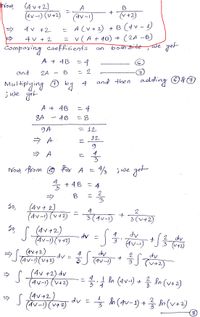Solve the differential equation with the appropriate method. Finalize answer free of fractions, logarithms, and express final answer equated to C. (2x - 5y + 3)dx - (2x + 4y - 6)dy = 0
Solve the differential equation with the appropriate method. Finalize answer free of fractions, logarithms, and express final answer equated to C. (2x - 5y + 3)dx - (2x + 4y - 6)dy = 0
Calculus: Early Transcendentals
8th Edition
ISBN:9781285741550
Author:James Stewart
Publisher:James Stewart
Chapter1: Functions And Models
Section: Chapter Questions
Problem 1RCC: (a) What is a function? What are its domain and range? (b) What is the graph of a function? (c) How...
Related questions
Question
Solve the differential equation with the appropriate method. Finalize answer free of fractions, logarithms, and express final answer equated to C. (2x - 5y + 3)dx - (2x + 4y - 6)dy = 0
Expert Solution
This question has been solved!
Explore an expertly crafted, step-by-step solution for a thorough understanding of key concepts.
This is a popular solution!
Trending now
This is a popular solution!
Step by step
Solved in 5 steps with 5 images

Follow-up Questions
Read through expert solutions to related follow-up questions below.
Follow-up Question
Hello, may I ask how was this part obtained? Why are there A and B? This part wasn't on our lesson so I was confused. Thank you so much in advance.

Transcribed Image Text:Now
(4 v+2)
A
(4v -1) (V+2) ¯ (4v-1)
+
(v+2)
(Av-1)
= A (v+2) + B (4v - 4)
= v (A + 46) + (2A -B)
4 v +2
4V + 2
Compaxing coefficients
both Side
e,we get
on
A + 4B =4
and
2A
= 2
and then adding O80
Multiplying
j we. get
by
4
A + 4B
8A
- 4B
=8
9A
= 12
12
6.
4
Now, Prom O for A = 3 we
get
+ 4B =4
B
2
ニ
50,
(4v + 2)
4.
2
(Av-1) (v+2)
3(4v-1)
3 (v+2)
Av+2)
(Av-1)()
4
dv
2
= AP
(1v-1)
(av+2)
4
; J लv-)
2
dv
= ^P
Av-1)(V42)
(4v +2) dv
(Av-1) (V+2)
4.1 In (Av-) + o (v+ 2)
(4v+2)
(Av-1) (v+2)
dv = a(4v-1)+응 h(v+)
Solution
Recommended textbooks for you

Calculus: Early Transcendentals
Calculus
ISBN:
9781285741550
Author:
James Stewart
Publisher:
Cengage Learning

Thomas' Calculus (14th Edition)
Calculus
ISBN:
9780134438986
Author:
Joel R. Hass, Christopher E. Heil, Maurice D. Weir
Publisher:
PEARSON

Calculus: Early Transcendentals (3rd Edition)
Calculus
ISBN:
9780134763644
Author:
William L. Briggs, Lyle Cochran, Bernard Gillett, Eric Schulz
Publisher:
PEARSON

Calculus: Early Transcendentals
Calculus
ISBN:
9781285741550
Author:
James Stewart
Publisher:
Cengage Learning

Thomas' Calculus (14th Edition)
Calculus
ISBN:
9780134438986
Author:
Joel R. Hass, Christopher E. Heil, Maurice D. Weir
Publisher:
PEARSON

Calculus: Early Transcendentals (3rd Edition)
Calculus
ISBN:
9780134763644
Author:
William L. Briggs, Lyle Cochran, Bernard Gillett, Eric Schulz
Publisher:
PEARSON

Calculus: Early Transcendentals
Calculus
ISBN:
9781319050740
Author:
Jon Rogawski, Colin Adams, Robert Franzosa
Publisher:
W. H. Freeman


Calculus: Early Transcendental Functions
Calculus
ISBN:
9781337552516
Author:
Ron Larson, Bruce H. Edwards
Publisher:
Cengage Learning